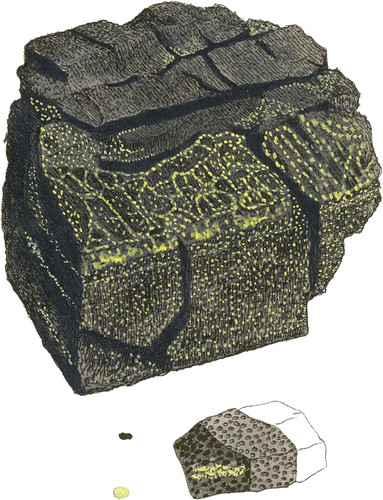 Enlarge
Enlarge
British Mineralogy
Oxide of Carbon, or Coak
- Class 1. Combustibles.
- Order 1. Homogeneous.
- Gen. 7. Carbon.
- Spec. 3. Oxide.
I have been favoured by different friends with Coak, or what is commonly termed Cinder, found near the Dyke of Whinstone*, or Blue-stone Dyke, which crosses Cockfield Fell, and other Coal-mines in the North. When the Coal in these mines is examined, we find it is the more like Coak or Cinder the nearer it is to the Whinstone. The figure will show the Coak-like fracture on the Coal at the upper part, which is the appearance it had when I first received it, and exactly corresponded with many more in the general nature and appearance of artificial Coak, in forming a horizontal columnar appearance, with cracks, arid burning without flame, &c. When examined with a lens, I found the perforations differing from artificial Coak, in being more smooth and .shining. The other part of the Coal w as not unlike common Coal at first appearance; but on nicer examination with a lens, I perceived little globules of Pyrites fitting to, and filling the hollows, and giving an idea that by their passing out the Coal would be rendered all like the upper part. I put it into a drawer with the other specimens in October 1804, and seldom looked at it till it became conspicuous this year, when the Pyrites had decomposed, and the Sulphur was passing out as figured, but with a different effect to what it seemed to have had in its native place; for, instead of leaving the Coal in the form of Coak, it was actually falling to pieces with another sort of fracture and tendency to crumble to dust, as it seems likely to do now very soon. The lower figure shows a fragment partly columnar, with the empty holes; the left hand end shows the Pyrites in the upper holes and the Sulphur below, corresponding with the figure of the little upper particle of iron Pyrites, and the Sulphur dust underneath. The Coal further from the Whin has fewer, but often larger, holes in it, and it sometimes has only a few. At the distance of a few feet the Coal is free from hollows, and bums like the best Newcastle Coal.
- Whin here must not be confounded with small-gained Granite: it is rattier a gray basalt including feldtspar. This dyke is of a very great extent.

